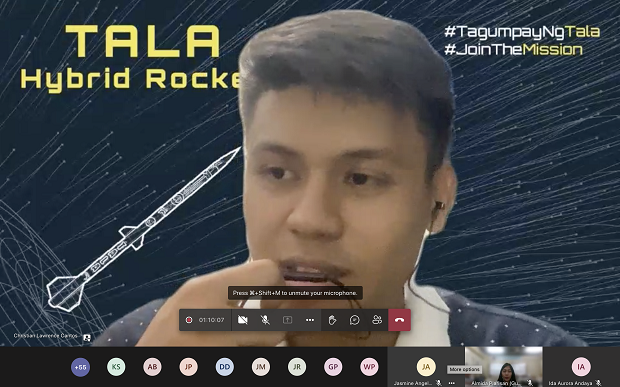The Philippine Space Agency (PhilSA) held a press briefing on Tuesday, May 23, to celebrate the successful launch of the TALA rocket, the country’s first high-powered hybrid rocket built by a team of students and their mentors from St. Cecilia’s College Cebu.
After an unavoidable reschedule due to weather conditions, the TALA rocket was finally launched from the Crow Valley Gunnery Range in Capas, Tarlac on Saturday, May 20.
Its rapid ascent was accompanied by the jubilant cheers of its team composed of five students — Christian Lawrence Cantos, John Harold Abarquez, Joshua Pardoria, Joefer Emmanuel Capangpangan, and Dorothy Mae Daffon — and their mentors Wilfredo Pardoria Jr. and Almida Plarisan.
According to Pardoria, the event was a success because it cleared its launch rail, exceeded its target altitude, reached an apogee or highest point of 3664 feet, deployed both its main and drogue parachutes, as well as deployed its Can Satellite (CanSat), which is a simulated satellite used in educational settings to remotely gather environmental data.
More importantly, the entire rocket was recovered at the end of the launch.
The rocket’s successful launch expands the tools available to the Philippine’s space R&D field. According to Plarisan, the country’s researchers rely on drones to deploy CanSats, but hybrid rockets can provide a safe and cost-effective alternative.
Particularly as a hybrid rocket, the TALA rocket’s mix of solid fuel and liquid oxidizer makes its handling, shipping, and storage safer compared to standard rockets.
Additionally, the TALA rocket is designed to be sustainable and is expected to lower the manufacturing cost of future rockets. Its hybrid engine is reusable past the first launch and the blueprints for its 3D printed carbon fiber parts can be utilized to manufacture the next rockets.
Besides its direct contributions to Philippine space technology, PhilSA director general Joel Joseph S. Marciano Jr. also hopes that the TALA’s success will light a fire under other young Filipinos.
He asserts that this team proves age is not a barrier to obtaining support and making important contributions to the country’s space technology.
“This [TALA rocket] is part of our larger efforts to really keep building and to have a renaissance of building again in our country and innovating… and that starts with young people,” Marciano said.
“They have these bright ideas and we have to encourage them, we have to give them an environment that enables them to continue innovating, bring those ideas forward, and bring them to reality,” he added.
TALA team leader Christian Lawrence Cantos addressed his peers directly: “Just go for it. It may be hard, it may be challenging, but it will always be worth it once you are there or once you have achieved it.”

The TALA Rocketry team also chimed in on the discussion about the benefits that could spring from nurturing the country’s latent talent in space technology.
By encouraging and supporting more young Filipinos to venture into this field, he said the Philippines could experience improvements in wide range of areas from more efficient search and rescue operations that prioritize communities urgently requiring aid due to better satellite images, as well as increased accuracy in climate and air quality readings.
The TALA team, aided by PhilSA, built their hybrid rocket funded by the Young Innovator’s Program of the Philippine Council for Industry, Energy, and Emerging Technology Research and Development (DOST-PCIEERD). The Philippine Air Force also supported this project.
The TALA rocket project began in 2018 and was originally planned to launch in 2020. However, its launch was delayed due to the Covid-19 pandemic.




